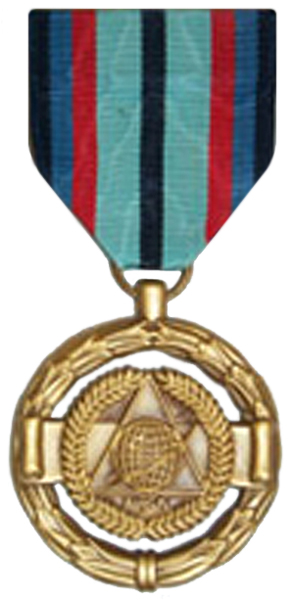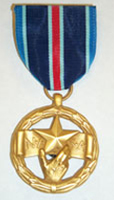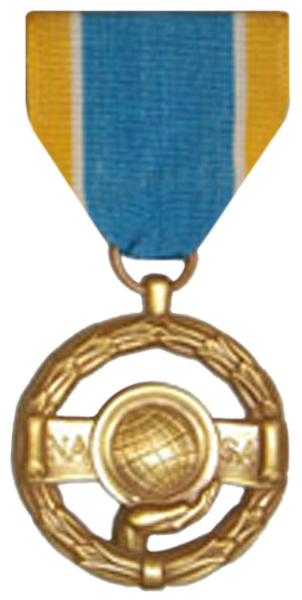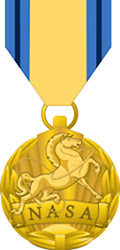
Steven Alan Hawley is a former NASA astronaut who flew on five U.S. Space Shuttle flights. He is professor of physics and astronomy and director of engineering physics at the University of Kansas.

The Congressional Space Medal of Honor was authorized by the United States Congress in 1969 to recognize "any astronaut who in the performance of his or her duties has distinguished himself or herself by exceptionally meritorious efforts and contributions to the welfare of the Nation and mankind." It's awarded by the President of the United States in Congress's name on recommendations from the Administrator of the National Aeronautics and Space Administration. The award is a separate decoration from the Medal of Honor, which is a military award for extreme bravery and gallantry in combat.

Harold (Hal) Masursky was an American astrogeologist.

The NASA Space Flight Medal is a decoration of the National Aeronautics and Space Administration. According to its statutes, it is awarded "for significant achievement or service during individual participation as a civilian or military astronaut, pilot, mission specialist, payload specialist, or other space flight participant in a space flight mission." In practice, the medal is bestowed upon any astronaut who flies aboard a United States space mission, and typically every subsequent flight is honored with an additional award.

The NASA Exceptional Achievement Medal is an award of the National Aeronautics and Space Administration established in 1991. The medal is awarded to both civilian members of NASA and military astronauts.

The NASA Exceptional Service Medal is an award granted to U.S. government employees for significant sustained performance characterized by unusual initiative or creative ability that clearly demonstrates substantial improvement in engineering, aeronautics, space flight, administration, support, or space-related endeavors which contribute to NASA programs.

The NASA Exceptional Administrative Achievement Medal is an award given by NASA to any person in the United States federal service for a significant, specific accomplishment or contribution characterized by unusual initiative or creativity that clearly demonstrates a substantial improvement in administrative support contributing to the mission of NASA, such as:

The NASA Exceptional Bravery Medal is a NASA award for exemplary and courageous handling of an emergency by an individual who, independent of personal danger, has acted to prevent the loss of human life or U.S. government property. The award is open to government and non-government employees.

William H. Gerstenmaier is an aerospace engineer and policymaker who is Vice President, Build and Flight Reliability at SpaceX. He previously served as NASA's Associate Administrator for Human Exploration and Operations between 2005 and July 10, 2019. While in that role, he was described as "arguably the most influential person when it comes to US spaceflight." Prior to being Associate Administrator, Gerstenmaier served as the International Space Station Office Program Manager, at Johnson Space Center, a position he began in June 2002. He spent a total of four decades with NASA.

The Silver Snoopy award is a special honor awarded to NASA employees and contractors for outstanding achievements related to human flight safety or mission success. The award certificate states that it is "In Appreciation" "For professionalism, dedication and outstanding support that greatly enhanced space flight safety and mission success." The award depicts Snoopy, a character from the Peanuts comic strip created by Charles M. Schulz.

The NASA Exceptional Technology Achievement Medal is an award given for technology contributions achieved in one of the following:

NASA's Exceptional Public Service Medal is a United States government awarded to any non-Government individual or to an individual who was not a Government employee during the period in which the service was performed for sustained performance that embodies multiple contributions on NASA projects, programs, or initiatives.

William J. (Bill) Borucki is a space scientist who worked at the NASA Ames Research Center. Upon joining NASA in 1962, Borucki joined the group conducting research on the heat shield for Apollo program spacecraft. He later turned his attention to the optical efficiency of lightning strikes in the atmospheres of planets, investigating the propensity that these lightning strikes could create molecules that would later become the precursors for life. Subsequently, Borucki's attention turned to extrasolar planets and their detection, particularly through the transit method. In light of this work, Borucki was named the principal investigator for NASA's Kepler mission, launched on March 6, 2009 and dedicated to a transit-based search for habitable planets. In 2013, Borucki was awarded the United States National Academy of Sciences's Henry Draper Medal for his work with Kepler. In 2015 he received the Shaw Prize in Astronomy.

TechPort is a Technology Portfolio System for the National Aeronautics and Space Administration (NASA). The TechPort system was created in response to a request by the Office of Management and Budget (OMB), resulting in the NASA Performance Goal 3.4.1.5 and APG 3.4.1.5: ST-12-17.
Document, coordinate, and prioritize Agency-level technology strategic investments to ensure NASA has a balanced portfolio of both near-term NASA mission (pull) technologies and longer-term transformational (push) technologies that benefit both Agency programs and national needs.
Ensure that 75 percent of all NASA technology projects are recorded in the portfolio database and are analyzed against the prioritizations in the space technology roadmaps.

Susan G. Finley, a native Californian, has been an employee of NASA's Jet Propulsion Laboratory (JPL) since January 1958, making her the longest-serving woman in NASA. Two days before Explorer 1 was launched, Finley began her career with the laboratory as a human computer, calculating rocket launch trajectories by hand. She now serves as a subsystem engineer for NASA's Deep Space Network (DSN). At JPL, she has participated in the exploration of the Moon, the Sun, all the planets, and other bodies in the Solar System.

The NASA Early Career Achievement Medal (ECAM) is awarded to any Government employee for unusual and significant performance during the first 10 years of an individual's early career in support of the Agency.

Adena Williams Loston is the 14th president of St. Philip’s College. She was installed as the new president in ceremonies on March 1, 2007. St. Philip’s College, located in San Antonio, Texas, is the only historically Black college and Hispanic-serving institution in the United States.

Claire Lucille Parkinson is an American Earth scientist and climatologist at NASA's Goddard Space Flight Center.

María Begoña Vila Costas is a Spanish astrophysicist specializing in the study of spiral galaxies. She currently resides in Washington, D.C. and works as a systems engineer at NASA's Goddard Space Flight Center. She is the lead engineer for the Fine Guidance Sensor and Near Infrared Imager and Slitless Spectrograph (FGS-NIRISS) on the James Webb Space Telescope – the Hubble's successor – in addition to being in charge of the final cold test of the group of instruments before their integration with the telescope.



















